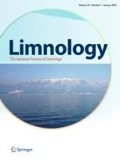Abstract
Vertical circulation reaches the bottom of the deepest (> 90 m) part of the northern basin of Lake Biwa, a warm monomictic lake, during winter (January to March) every year. In winter 2019, we found non-circulated water masses at the bottom of the lake where the basin is 90 m deep. This is the first observation of an incomplete vertical circulation event since we started monitoring Lake Biwa in 1979. Analysis of water quality monitoring and meteorological data shows that weaker cooling and weaker winds during winter 2019 affected vertical circulation. Dissolved oxygen concentrations in the bottom layer recovered even after the appearance of a seasonal thermocline. However, the concentrations remained below that in the surface layer.







References
Akitomo K, Tanaka K, Kumagai M, Jiao C (2009) Annual cycle of circulations in Lake Biwa, part 1: model validation. Limnology 10:105–118
Akimoto K, Tanaka K, Kumagai M (2009) Annual cycle of circulations in Lake Biwa, part 2: mechanisms. Limnology 10:119–129
Arai T (2009) Climate change and variations in the water temperature and ice cover of inland waters (in Japanese). Jpn J Limnol 70:99–106
Robarts RD, Waiser MJ, Hadas O, Zohary T, Maclntyre S (1998) Relaxation of phosphorus limitation due to typhoon-induced mixing in two morphologically distinct basins of Lake Biwa, Japan. Limnol Oceanogr 43:1023–1036
Endoh S, Yamashita S, Kawakami M, Okumura Y (1999) Recent warming of Lake Biwa water (in Japanese). Jpn J Limnol 60(2):223–228
Fer I, Lemmin U, Thorpe SA (2002a) Winter cascading of cold water in Lake Geneva. J Geophys Res 107:3060. https://doi.org/10.1029/2001JC000828
Fer I, Lemmin U, Thorpe SA (2002b) Observations of mixing near the sides of a deep lake in winter. Limnol Oceanogr 47:535–544
Hayami Y, Fujihara T (1999) Recent warming of the deep water in Lake Biwa (in Japanese). Umi no kenkyu 8:197–202
Hutchinson GE, Löffler H (1956) The thermal classification of lakes. Proc Natl Acad Sci USA 42:84–86
Jassby A, Powell T (1975) Vertical patterns of eddy diffusion during stratification in Castle Lake, California. Limnol Oceanogr 20:530–543
Kawanabe H, Nishino M, Maehata M (eds) (2012) Lake Biwa: Interactions between nature and people. Springer Science, Tokyo
Kitazawa D, Kumagai M (2008) Ecosystem simulation on the effect of climate change on material cycle in Lake Biwa (in Japanese). Seisan kenkyu 60(1):46–50
Lake Biwa Environmental Research Institute (2008) Annual report of Lake Biwa Environmental Research Institute (in Japanese) 3:125–129
Oonishi Y (1975) Surface interpolation by a spline technique (in Japanese). J Oceanogr Soc Jpn 31:259–264
O’Reilly CM, Alin SR, Plisnier P, Cohen AS, McKee BA (2003) Climate change decreases aquatic ecosystem productivity of Lake Tanganyika, Africa. Nat 424:766–768
Shiga-Prefecture (2018) Environmental white paper in 2018 (Reference) pp 11–48 http://www.pref.shiga.lg.jp/file/attachment/4042993.pdf. Cited 1 Jan 2020
Wahl B, Peeters F (2014) Effect of climatic changes on stratification and deep-water renewal in Lake Constance assessed by sensitivity studies with a 3D hydrodynamic model. Limnol Oceanogr 59:1035–1052
Wetzel RG (2001) Limnology: Lake and River ecosystems, 3rd edn. Academic Press, San Diego
Yoshimizu C, Yoshiyama K, Tayasu I, Koitabashi T, Nagata T (2010) Vulnerability of a large monomictic lake (Lake Biwa) to warm winter event. Limnology 11:233–239
Acknowledgements
We thank Professor Shin-ichi Nakano of Kyoto University for his valuable comments and suggestions. The first author of this paper, Mr. Kenta Yamada passed away in November 2020 after submission. He was a researcher at Lake Biwa Environmental Research Institute, and had a passion for monitoring and researching the water environment in Lake Biwa. He remains in our memory for his lake monitoring and research work and also for compiling this paper and making significant contributions to it.
Author information
Authors and Affiliations
Corresponding author
Additional information
Handling Editor: Daisuke Kitazawa.
Publisher's Note
Springer Nature remains neutral with regard to jurisdictional claims in published maps and institutional affiliations.
Supplementary Information
Below is the link to the electronic supplementary material.
Rights and permissions
About this article
Cite this article
Yamada, K., Yamamoto, H., Hichiri, S. et al. First observation of incomplete vertical circulation in Lake Biwa. Limnology 22, 179–185 (2021). https://doi.org/10.1007/s10201-021-00653-3
Received:
Accepted:
Published:
Issue Date:
DOI: https://doi.org/10.1007/s10201-021-00653-3

